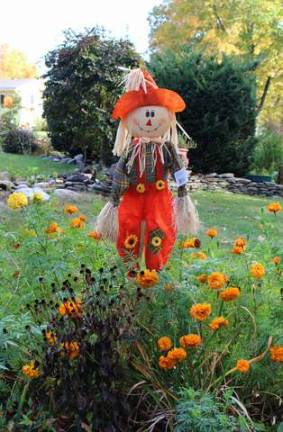By Ginny Raue
Riding along Ridge Road in West Milford a beguiling little scarecrow set among colorful autumn blooms catches your eye. He’s a well-dressed little guy with a grin that makes you want to smile back. Such wasn’t always the case in the scarecrow family; some of his ancestors were downright formidable.
Scarecrows in Ancient Egypt
The Great Pyramids and scarecrows came into being around the same time. It was the age of the “Old Kingdom” and while architect Imhoptep was drawing up plans for the first pyramid, Egyptian farmers were designing the first recorded scarecrow.
Along the Nile River, wheat farmers were fed up with losing their crops to flocks of quail. Their response was to erect wooden frames covered with nets, set out in their fields.
Well, that wouldn’t scare many birds, you may say - and you’d be correct. But this scarecrow scenario came with a bit of a twist. The farmers hid themselves in the fields and when the quail arrived they’d shoo them into the nets. Next thing you know there was a golden, roasted quail on the dinner table. Quail gone, stomachs full, problem solved.
A face only a mother could love
The Ancient Greeks took an alternative approach, carving wooden scarecrows to resemble Priapus, a god of fertility and horticulture. While it doesn’t speak well of Priapus’ outward appearance, it was deemed to be ugly enough to frighten the birds away. Add the coat of purple paint, a club in one hand and a sickle in the other; it may have scared a few farmers’ kids as well.
The Romans took a liking to the Priapus prototype and as they traipsed through Europe Priapus doppelgangers dotted the landscape in their wake.
Japan, Germany and Britain
Around the same time, Japanese farmers had their rice fields to protect. Their idea of a scarecrow, called Kakashis, was human in form but, for whatever reason, they were dressed in raincoats and straw hats, holding bows and arrows. It is assumed that an odd looking guy in a raincoat in a lonely field was not scary enough unless he was armed.
The Germans chose a witch figure for their scarecrows that performed double duty; scaring the birds away while the sorceress image was believed to hasten the planting season. In Britain young boys and girls could presumably pick up some pocket pence by acting as live scarecrows or “bird scarers.” They’d travel the fields, throwing stones, wildly flapping their arms.
Eventually farmers began to construct scarecrows that more resemble what we know today. They were made of sacks of straw with a gourd for a head, propped against a pole.
Coming to America
Native Americans used “bird scarers” or scarecrows and Creek Indian families moved into shelters in their fields during growing season. Zuni Indian children participated in scariest scarecrow competitions.
Pilgrim sentries patrolled the growing fields until they turned to the dependable scarecrow. German immigrants dressed their figures in tattered clothing with a red bandana tied around its neck. They were called “Bootzamon” – later “Bogeymen.”
After World War II field spraying or dusting replaced the scarecrow for a time – until the dire nature of such chemicals as DDT was discovered.
Scarecrows today
Scarecrows are still in use around the globe although some growers now use more high tech deterrents, such as the automatic noise gun or the digital effigy that emits ultrasonic waves.
In some Arab countries and in India old men sit in chairs and lob rocks at the birds; a throwback to the “bird scarers.”
So, if you see an elderly gentleman in West Milford appearing to be resting on his laurels in a lawn chair, look closely, see if he has a pile of stones next to him. He may be gainfully employed and supplementing his Social Security checks.
http://historybecauseitshere.weebly.com
http://modernfarmer.com
